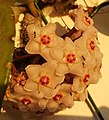Hoya carnosa
| Hoya carnosa | |
|---|---|

| |
| Scientific classification | |
| Kingdom: | Plantae |
| Clade: | Tracheophytes |
| Clade: | Angiosperms |
| Clade: | Eudicots |
| Clade: | Asterids |
| Order: | Gentianales |
| Family: | Apocynaceae |
| Genus: | Hoya |
| Species: | H. carnosa
|
| Binomial name | |
| Hoya carnosa | |
Hoya carnosa, the porcelainflower or wax plant, is an Asclepiad species of flowering plant in the dogbane family Apocynaceae. It is one of the many species of Hoya that are native to Eastern Asia and Australia. It is a common house plant grown for its attractive waxy foliage, and sweetly scented flowers. It is grown well in pots and hanging baskets.
Hoya carnosa has been in cultivation for more than 200 years and has given rise to many cultivars that vary in foliage form or flower color. In cultivation in the UK it has gained the Royal Horticultural Society’s Award of Garden Merit.[1][2]
Description
Hoya carnosa makes faintly succulent shoots with smooth, pale gray, and bare surfaces that writhe and climb. The shoots are soft at first, but lignified later. The perennial leaves are stalked with about 1 to 1.5 cm long stems. The blade is wide oval to longitudinal oval or heart-shaped. The leaves are slightly succulent, fleshy with a waxy glossy surface. The stem is up to about 10 cm long. The leaves, ovate or elliptical, are 3-5 cm wide and 3.5-13 cm long, with a petiole of about 1-1.5 cm. The intersteaminal side lobes are pointed oval to lanceolate, the top is convex. The outer end is white, the inner end dyed red. The spindle-shaped fruits measure 6 to 10 × 0.5 to 1.5 cm.[3]
Flowers

The inflorescence is made up of numerous flowers, hanging or more upright, which are grouped in an umbel. The flowers are typically light pink, but may vary from near-white to dark pink; they are star-shaped, and are borne in clusters that look like tiny wax miniatures. The surface of the flowers is covered in tiny hairs giving them a fuzzy sheen. They are heavily scented and may produce excess nectar that drips from the flowers. The flower crown has a diameter of 1.5 to 2 cm and is whitish to slightly pink coloured.[4]
Like all species of Hoya, H. carnosa flowers from specialised perennial structures referred to as spurs. These appear from the axils of the leaves and stem; flowers may not be produced when the spurs first appear, but in time buds emerge from the tips. Each season new flowers are produced on these same spurs, so they should not be damaged or removed.
The plant flowers from spring to late summer, it can produce umbels of 10 to 50 small star-shaped flowers that mature gradually (2 to 3 weeks) on the same peduncle. The scent is nocturnal with a pheromonal tendency.
Range
This species is found in Queensland, East India, in southern China (Fujian, Guangdong and Yunnan provinces, and Guangxi autonomous region), Taiwan, Myanmar, Vietnam, Malaysia, the Japanese islands of Kyushu and Ryukyu, where it grows in humid subtropical forests, and the Fiji Islands.
Cultivation
This Hoya species prefers bright light, but will tolerate much less. Though it will tolerate low temperatures (but not freezing),[1] the optimal temperature is 60–85 °F (16–29 °C). It can be propagated by air layering or by stem cuttings. It benefits from an open potting medium that allows some air to get to the roots. Typical mixes include large-grade drainage material such as perlite, pumice, or ceramic balls. The plants should be fed regularly with a fertilizer suitable for epiphytic plants.
There is a persistent piece of folklore that hoyas prefer to be potbound - kept in a small pot. It is said that this will hasten flowering.[5]
Studies at the University of Georgia, published in 2009, have shown H. carnosa to be an excellent remover of pollutants in the indoor environment.[6]
Gallery
-
Leaves
-
Flower cluster
-
Flower clusters
-
Closeup of flowers
-
Hanging flowers
-
Flower, which looks like a furry starfish
-
Inflorescence
-
Flower cluster under bright light
-
Tapinoma israele drinking nectar of Hoya carnosa
References
- ^ a b "RHS Plantfinder - Hoya carnosa". Retrieved 3 March 2018.
- ^ "AGM Plants - Ornamental" (PDF). Royal Horticultural Society. July 2017. p. 49. Retrieved 2 March 2018.
- ^ Focke Albers, Ulli Meve (ed.): Succulent Encyclopedia. Asclepiadaceae (milkweed plants) . Eugen Ulmer, Stuttgart 2002, ISBN 3-8001-3982-0 , p 150
- ^ "Hoya carnosa - Wax Plant, Asclepiadaceae". Plant of The Week. University of Oklahoma Department of Microbiology & Plant Biology. May 1999. Archived from the original on April 17, 2008. Retrieved December 6, 2015.
- ^ "Hoya Plant: How To Care For The Wax Plant". Plant Care Today. 2016-05-26. Retrieved 2017-06-07.
- ^ "UGA research shows some plants can remove indoor pollutants". UGA.edu. University of Georgia. March 31, 2009. Retrieved December 6, 2015.
Bibliography
- Hoya carnosa: information in The Plant List
- Trimen, Henry (1888). Hortus Zeylanicus; A Classified List of the Plants, Both Native and Exotic, Growing in the Royal Botanic Gardens. P.R. Deniya. ISBN 9781236067777.
- Phillips, Roger (1997). The Random House Book of Indoor and Greenhouse Plants (Vol. 2). New York, NY, U.S.A.: Random House, Incorporated. ISBN 0375750282.









